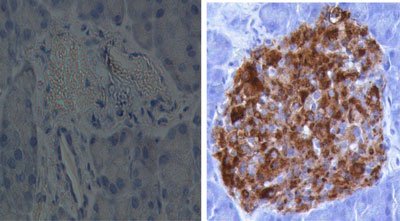IL-35 injections show promise as type 1 diabetes treatment
Posted: 30 July 2015 | Victoria White
Administration of IL-35 to mice with type 1 diabetes reverses or cures the disease by maintaining a normal blood glucose level and immune tolerance…


A representative image of islets from diabetic mice, which did not receive IL-35 (left) and received IL-35 (right). The brown color represent insulin producing beta cells. CREDIT: Kailash Singh
New research from Uppsala University shows promising progress in the use of anti-inflammatory cytokine for treatment of type 1 diabetes.
The study reveals that administration of interleukin-35 (a protein made by immune cells) to mice with type 1 diabetes, reverses or cures the disease by maintaining a normal blood glucose level and immune tolerance.
Type 1 diabetes (T1D) is a chronic disease, which for the patients leads to a life-long dependence of daily injections of insulin. The exact cause of T1D is not yet known, however, it is considered as an autoimmune disease. It is thought that an infection and/or unknown factors probably triggers the immune cell attack, which ultimately leads to an insufficient insulin production.
In the new study, Dr Kailash Singh, a PhD student in professor Stellan Sandler’s research group at the Department of Medical Cell Biology at Uppsala University, studied so-called immune regulatory T cells’ actions in T1D mouse models. The study shows that the immune regulatory T cells alter their function by producing pro-inflammatory destructive proteins instead of protective anti-inflammatory proteins such as interleukin-35 (IL-35) under T1D conditions.
“This suggests that the good guys have gone bad in early development of Type 1 diabetes and therefore our immune cells destroy the beta cell”, says Dr Kailash Singh.
Furthermore, the concentration of IL-35 was lower in T1D patients compared to healthy individuals. These findings may suggest that IL-35 could play a crucial role in human T1D. In addition, the researchers have found a novel mechanism that explains how the immune regulatory T cells are changing their role under a T1D condition.
IL-35 injections normalised blood glucose concentrations
Professor Sandler’s research team tested whether or not IL-35 could also suppress development of T1D and reverse established T1D. To induce T1D in mice they injected a chemical compound called streptozotocin. These mice developed signs of T1D with increasing blood glucose levels. IL-35 injections given after disease induction prevented from development of T1D. Strikingly, IL-35 injections to mice, which were diabetic for two consecutive days, normalised blood glucose concentrations.
The findings encourage further research on the use of IL-35 for treatment of T1D and offer new clues as to why immune regulatory T cells fail in counteracting T1D.
“To the best of our knowledge, we are the first to show that IL-35 can reverse established Type 1 diabetes in two different mouse models and that the concentration of the particular cytokine is lower in Type 1 diabetes patients than in healthy individuals. Also, we are providing an insight into a novel mechanism: how immune regulatory T cells change their fate under autoimmune conditions”, says Dr Kailash Singh.
The study findings are published in Scientific Reports.
Related conditions
Diabetes
Related organisations
Uppsala University



